I can still picture my daughter lying in the grass wearing her pajamas and Wonder Woman rainboots, examining a small patch of mushrooms. The spring before last was unusually wet and our yard often looked like a rice paddy. The garden drank in the moisture. And mushrooms sprouted. I grew up in the Midwest, where finding a mushroom in the grass is ordinary. To my Coloradan child, it was an exciting treasure. She spent timeless stretches looking for the fungi, plucking them, examining their gills, then bringing them to me as a gift.
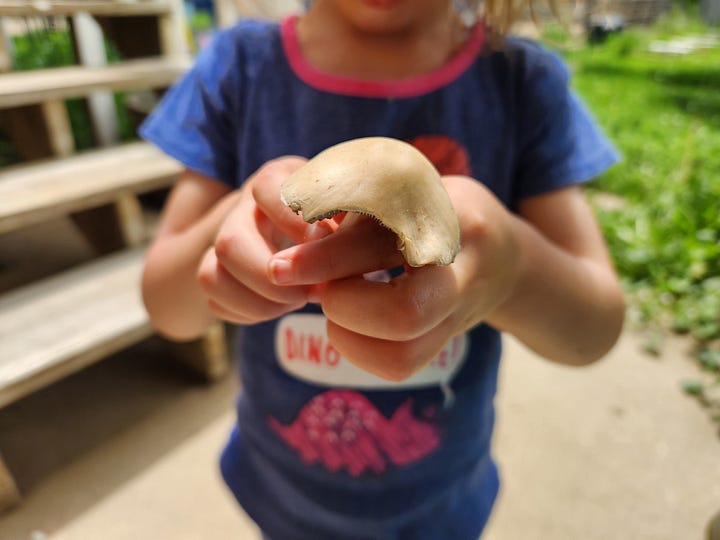
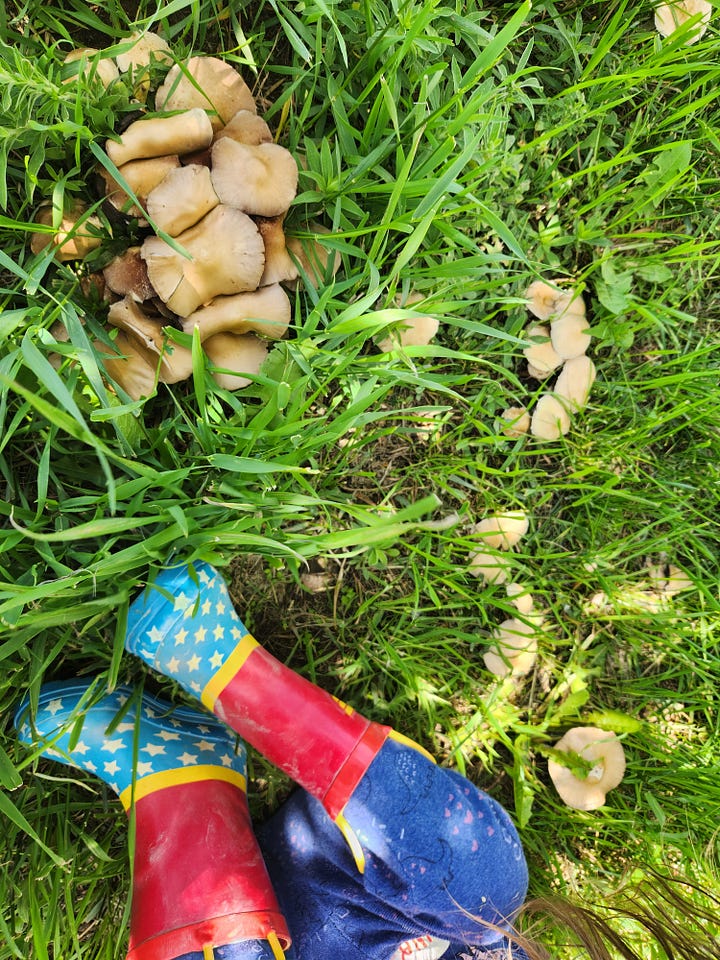
The experience planted a little spore of obsession, nurtured when my daughter’s class studied mushrooms. Her teacher and I chatted about how much she enjoys the mushroom growing kits and I decided we should try one at home.
While our pink oyster mushrooms grew from tiny pins to big, beautiful fungi, I checked out a stack of library books on mycology. My daughter took them to her room and looked at them at bedtime for a month before I borrowed them back.
In Doug Bierend’s In Search of Mycotopia, University of Utah professor Bryn Dentinger explains that a childhood fascination with mushrooms led to his career studying them:
My mom gave me a mushroom guide and said, ‘Hey, can you tell me what these mushrooms are in our yard?’...And I think the thing that really reinforced that fascination early on is that, when you go on a foray, it’s a treasure hunt, and what kid doesn’t like to go on a treasure hunt?
My family was also drawn into that treasure hunt, curious about the whimsical names and strange colors of various fungi.
Humans have a long history of viewing mushrooms as mystical, delicious, and dangerous. As we looked through the books, I gained a deeper appreciation of the connection among fungi, witchcraft, fairytales, medicine, and magic. I started to see why now, at this moment, mushrooms are such a sensation. As we face intense stress, struggle for wellness, and worry over damage we have done to the natural world, mushrooms can seem like a panacea. Adaptogens help us chill. Mycorrhizal networks help trees communicate with each other. Whatever happened to that fungus that eats plastic waste? Put that guy to work already! My favorite idea I came across in the research is the notion that we might relearn a better, more connected, way of living from fungi.
As Merlin Sheldrake writes in Entangled Life:
Fungi are veteran survivors of ecological disruption. Their ability to cling on—and often flourish—through periods of catastrophic change is one of their defining characteristics. They are inventive, flexible, and collaborative. With much of life on Earth threatened by human activity, are there ways we can partner with fungi to help us adapt?
This month, continuing the vibe of last month’s Goblin Core and making moss art, I centered my Pronking Year activities on exploring fungi. Really getting into the process of slowing down, it has taken six weeks to complete all the components of this report. Longer, if you count reading the books.
Mushroom Growing Kits
The first kit we tried came from Back to the Roots and we grew a big crop of Pink Oyster mushrooms with shocking speed (Related: We Did Some Kitchen Science). They were delicious. For Christmas, Julio’s parents gave me a kit to grow Blue Oyster mushrooms and his sister gave me the wonderfully illustrated book Mushrooming. Blue mushrooms take more precise levels of light, temperature, and humidity to develop their color. I did not hit the sweet spot, so although the mushrooms were wonderful on a bowl of pad thai, they were not quite blue. They also produced so many spores, it looked like stalactites in a cave. We tried and failed making a spore print.
From Fox Fungi, I got a substrate that had been started as part of their mushroom farm but was not quite the quality that the restaurants they supply look for. So, I cut out what had already sprouted and started over. We got an abundance of King Blue mushrooms, a hybrid of King Trumpet and Blue Oyster Mushrooms.
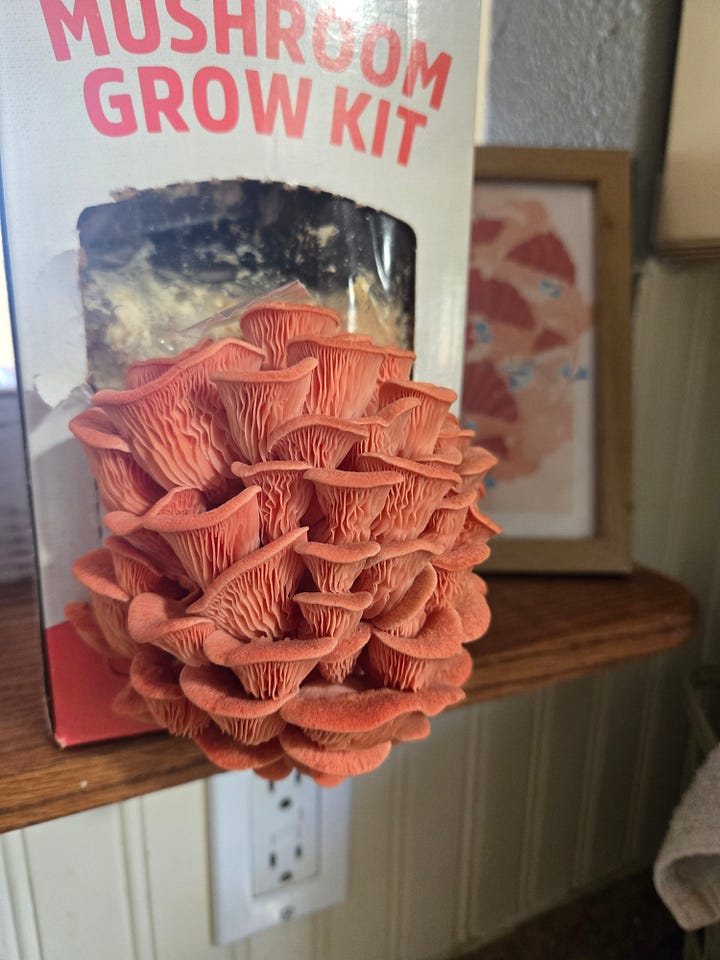

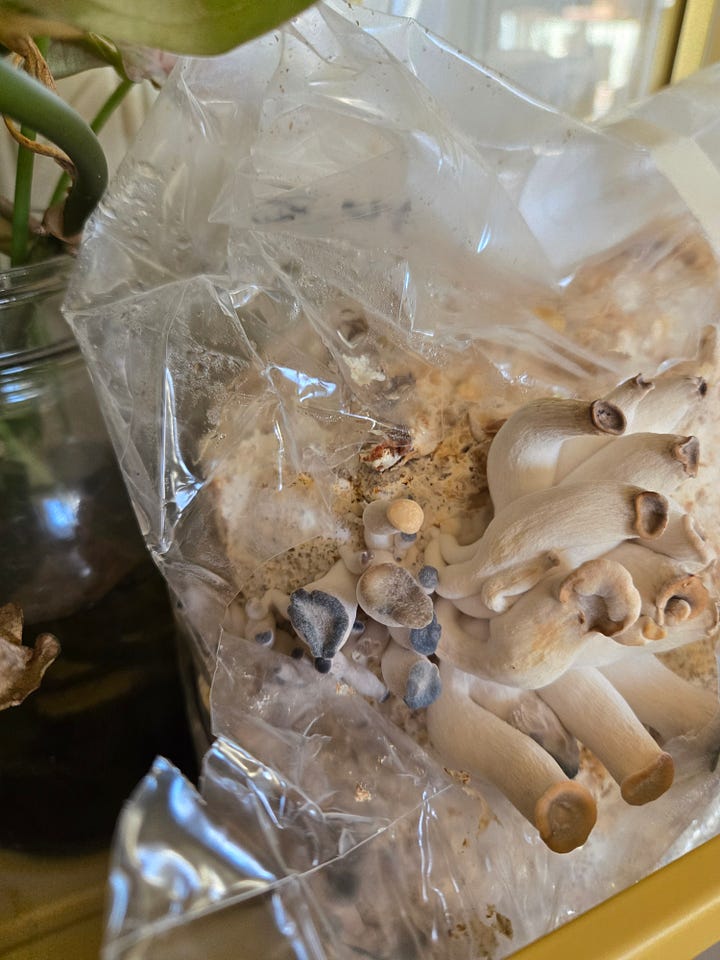
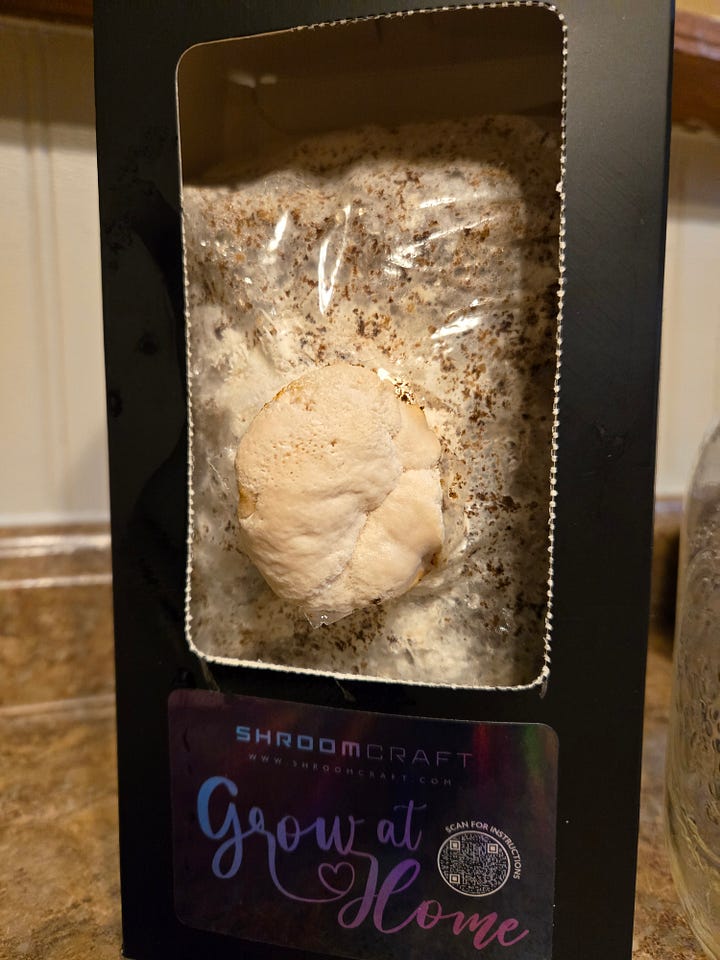
We also got a kit for growing Lion’s Mane mushrooms from ShroomCraft. The results of the various kits were inconsistent but watching our mushrooms develop and eating them at dinner was always gratifying. It was easy to understand how people get obsessed with foraging or growing fungi.
Foraging at Front Range Mushroom Shops
Over several expeditions, we visited mushroom businesses across the Front Range. We did not make it to Hazel Dell Mushrooms in Fort Collins (yet?), but we visited an apothecary in Loveland, a cafe in Boulder, and mushroom farms in the Denver Metro. And, I only joked about Cordyceps zombies once. Please be proud of me. All of their websites are linked below, if you are not local, but still want to shop.
Fox Fungi
After finding one place closed and one that looked like the kind of mushroom shop where I did not want to take my preschooler, we were relieved that Fox Fungi was both open and friendly. This urban mushroom farm is compact but full of diverse fungi. One of the co-owners, Kevin, was kind enough to show us where they grow the mushrooms and talk with me about how to set up a humidifier on a short-cycle timer.
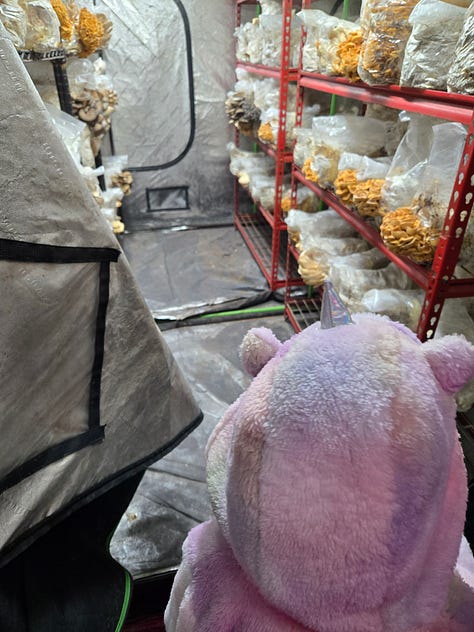
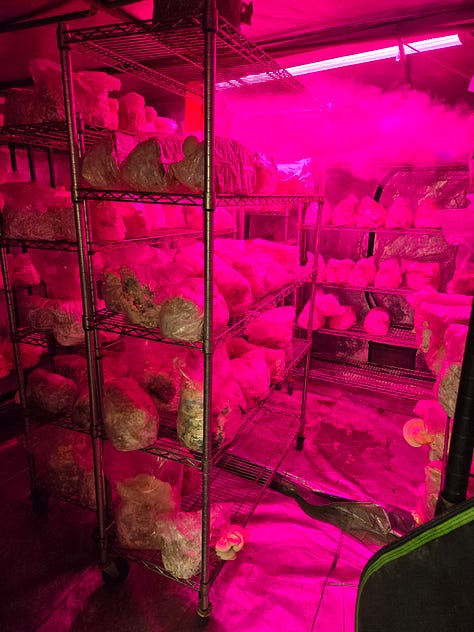
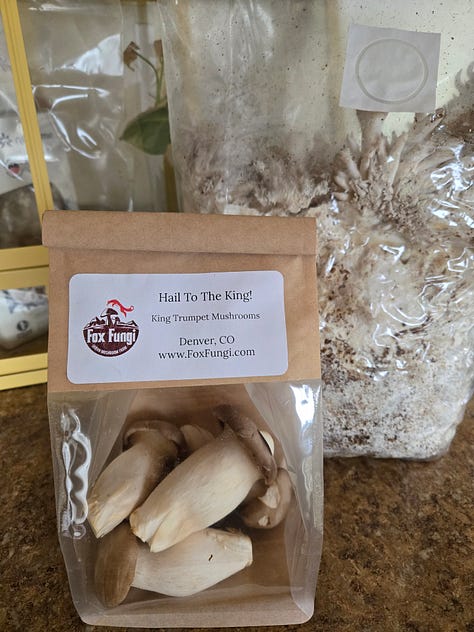
We discussed the challenges of growing mushrooms in Colorado’s dry climate and he mentioned that some people run spent substrate from their farm through their compost. There may not be spores to grow more mushrooms, but the mycelium is still there, which is so healthy for the soil. And some still have mushrooms sprout in their gardens. I had visions of mushrooms growing among the pumpkin vines while we picked out King Trumpet Mushrooms for dinner and wrote down the instructions for the mushroom kit we were taking home. My kiddo loves raw mushrooms, so she nibbled on one while we drove to our next stop.
Fox Fungi offers mushrooms at markets throughout Denver and at their storefront. If you’re local, I recommend them as a source if you like to cook mushrooms.
Myco Cafe
When we visited Myco Cafe, the owner was in the midst of working the counter and rearranging plants. The afternoon lull gave us a chance to look at the gorgeous mushroom-inspired art and flyers for events while we enjoyed refreshments.
The menu follows a formula in which you pick a drink base, a mushroom infusion, milk type, and a sweetener. I had a golden latte with a Lion’s Mane infusion and oat milk, no sweetener. It was yummy and pretty. My daughter got a comically large chocolate chunk muffin. You can also buy syringes of mushroom cultures to grow at home. The vibe is very Boulder, earthy and fun. I’m sure we will return the next time we are in the area.
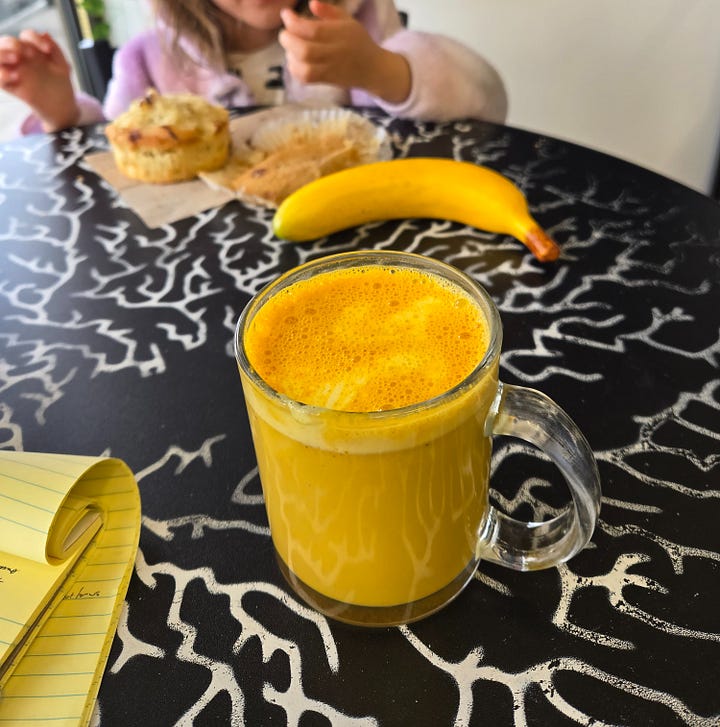
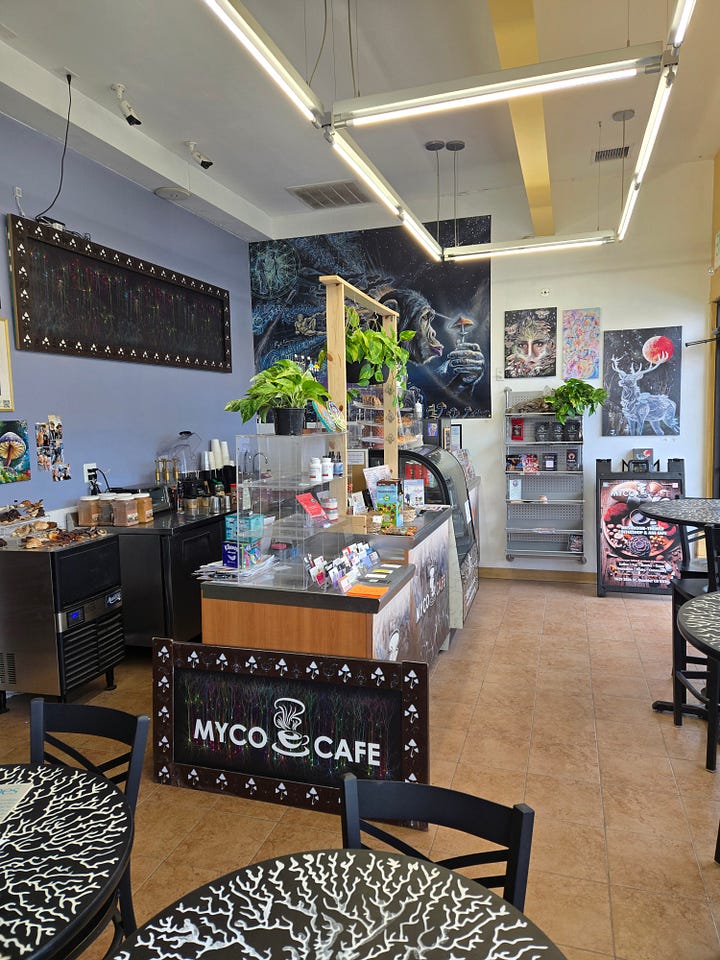
ShroomCraft
Whereas Fox Fungi looks like a compact farm, ShroomCraft feels more like a laboratory. The owner showed me around their mushroom tents and equipment and talked me through the various mushroom-growing supplies they sell. I left with a Lion’s Mane kit that I only needed to cut and mist. It is currently growing rapidly.
ShroomCraft specializes in the medicinal and wellness benefits of mushrooms (although they also grow mushrooms to eat) and sells a variety of mushroom drinks, tinctures, and capsules. I got a Lion’s Mane powder, which I have been mixing into an afternoon matcha to help my world-weary brain. They also have products made from Reishi, Cordyceps, and Turkey Tail, and articles on their website about the benefits of each.
Orion’s Apothecary
Orion’s Apothecary, an adorable shop in Loveland, sells mushroom products such as teas, tinctures, grow kits, more advanced equipment, books, and art. They also have on-site classes for beginners. I am considering the Mushroom Foraging Class in April.
The clerk who helped us was very sweet and we enjoyed browsing the variety of products from the mushroom supplies to locally made soaps, a beautiful rhinoceros beetle curio, and stickers. I wish I lived closer to this pretty little boutique that also operates as a community hub for the fungi-curious.

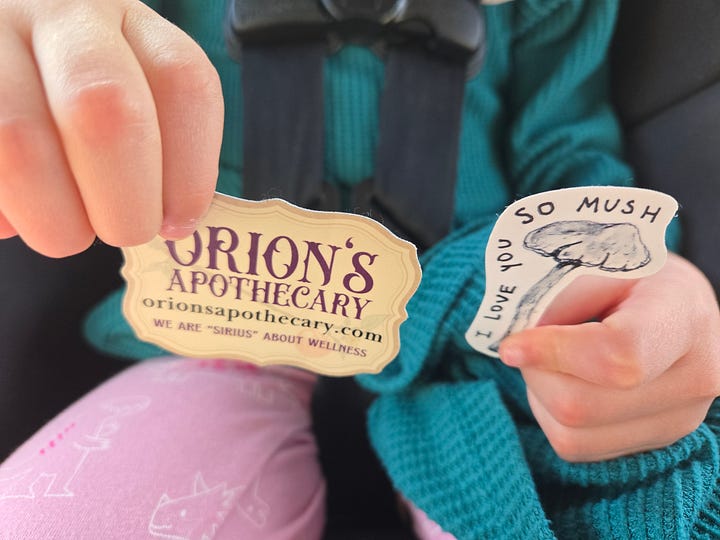
Making Mushroom Earrings
During our forage, I saw a stand of mushroom earrings, including some made from polymer clay. They reminded me of fifteen years ago when I had a side hustle making dirigible plum earrings. In the Harry Potter books, Luna Lovegood (who I feel a kinship for) wears dirigible plums, a radish-like fruit thought to enhance the wearer’s ability to accept the extraordinary. I wanted a pair and decided to make them myself. They came out well enough that I also made some for friends and eventually set up shop on Etsy. I sold the earrings for almost ten years and there were many months when they paid for my apartment’s modest utility bill.
I decided to make mushroom earrings for my slow project this month. I even used the same colors as my dirigible plum earrings to make Fly Agaric mushrooms, the type most famous for inspiring the mushrooms in Alice in Wonderland. I flipped through my mushroom book to find another specimen that would look good as an earring. So many with the more creative names (Elfin Saddle, Inky Cap, Dead Man’s Fingers) would not make visually appealing jewelry, but I decided to try Amethyst Deceiver too.
The earrings came out sort of well. They are a bit big, and I have some adjustments in mind if I make more. The Fly Agaric are better than the Amethyst Deceiver, but I will try again. The best part was that my kid was working with her art supplies next to me and decided to make mushrooms too, measuring them against the pictures on the cover of our book.
Curiouser and Curiouser
A highlight of our field trips was watching someone’s whole face light up when I mentioned growing mushrooms at home. Touring their humidity tents and seeing the variety of mushrooms while they detailed the process provided a wonderful glimpse of the passion that turned curiosity into a business. I’m sure that feeling of joy in the process is common to local farms and I plan to explore it further in my growing season.
There is still so much I want to learn. Julio is worried that I am going to sprout a mushroom farm in the house. I am composting substrates. I want to try making more mushrooms out of clay! And there are always more books to read.
Mushroom Books
Entangled Life: How Fungi Make Our Worlds, Change Our Minds & Shape Our Futures
Mushrooming: An Illustrated Guide to the Fantastic, Delicious, Deadly, and Strange World of Fungi
In Search of Mycotopia: Citizen Science, Fungi Fanatics, and the Untapped Potential of Mushrooms
Mystical Mushrooms: Discover the Magic & Folklore of Fantastic Fungi
I have a Bookshop.org list with all these titles, all are affiliate links.
I know that people have diverse reactions to mushrooms. Do you like mushrooms? Do you have a favorite mushroom recipe? (Here are mine) A specimen you love? Do they give you the ick? Let me know in the comments.




What a fun read! I’ve never explored the mushroom kingdom but I realize I am missing something magical and profound. How fun! I used to live in CO and people were constantly foraging in the area. Thanks for writing!
We love mushrooms. If you find them yellow oysters are great with seafood! I’m feeling very jealous. Our local year round farmers’ market closed in early Dec and now I can’t get my weekly haul from Miller’s. I wish you and V could have met Lexie. She LOVED mushrooms and was always on the lookout. We found so many different ones on our last day hiking in Scotland.